Indoor tradescantia - description of species and varieties, home care
Tradescantia got its official name from Karl Linnaeus - so he immortalized the names of its discoverers. Back in the 17th century, two English travelers - a father and a son named Tradescant - were the first to discover this beauty. The natural habitat of this plant is North and South America.
- Description of the species
- Popular varieties
- Thick-leaved (thick-leaved)
- White-flowered (Albiflora)
- Blossfeld (Thai)
- Setcreasia, or purple
- Riverside (Fluminensis)
- Quadricolor
- Sitara, or Reo
- Nanouk
- Striped (zebrina)
- Yellow hill
- Lodges
- Somali (Cyanotis)
- Callisia
- Blossfeld
- Sillamontana, or Felt
- Spatacea, or multicolor
- Scaphoid (navicularis)
- Pallida (Purple Heart)
- Virginia
- Pink Joy
- Garden varieties and hybrids
- Purchase and adaptation
- Planting and transplanting
- Growing conditions at home
- Seat selection
- Humidity
- Temperature
- Lighting
- Care
- Watering
- Pruning and clothespin
- Fertilizers and feeding
- Reproduction methods
- Seeds
- Layers
- Cuttings
- Dividing an adult plant
- Diseases and pests
- Healing properties
- Useful videos
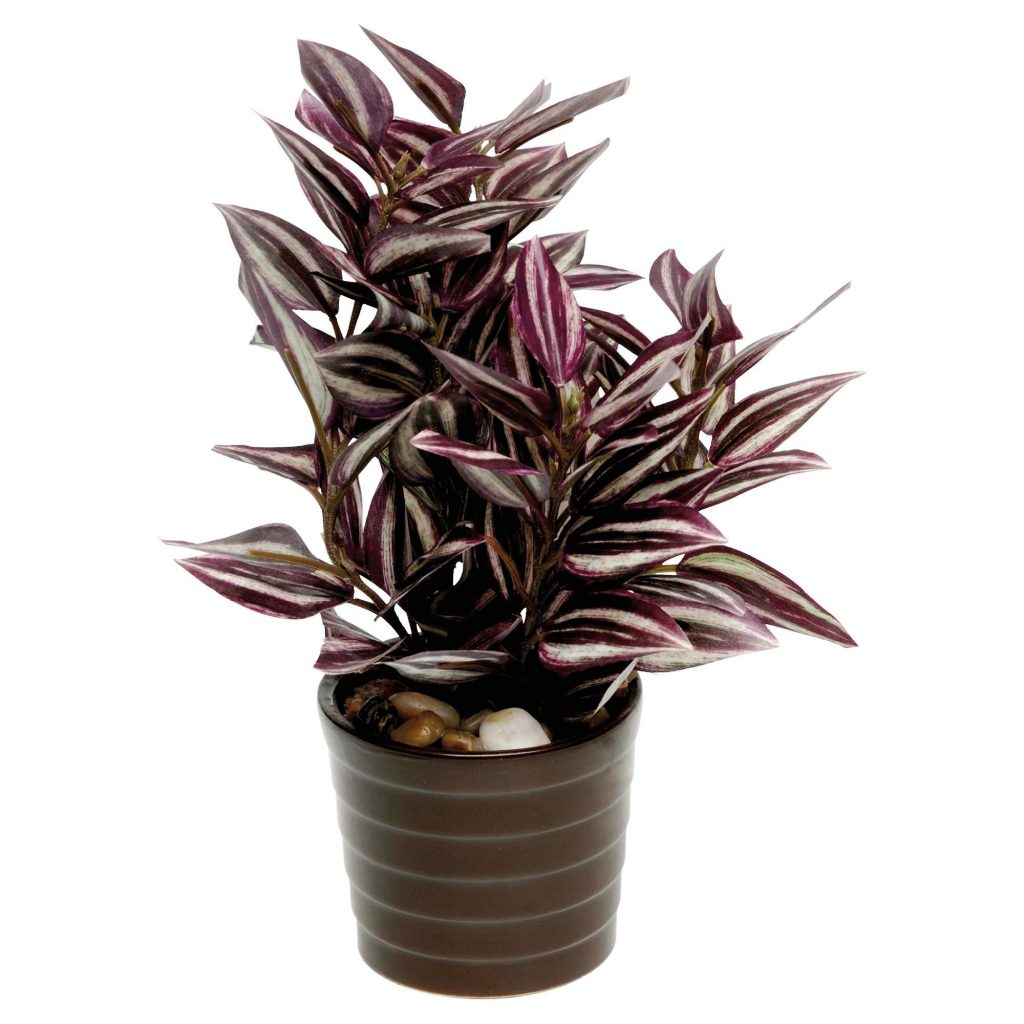
Shank of tradescantia in a vessel
Description of the species
Common Tradescantia includes 75 species and more than a thousand varieties. This herbaceous ornamental deciduous plant is grown in the garden and at home. It is often used as a ground cover in flower arrangements.
Shoots are long, creeping or straight, branching close to the ground. Leaves come in different shapes - from ovoid to narrow, pointed. Inflorescences are formed in the upper axils of the leaves or at the very top of the shoots.
A distinctive feature is the ability to reproduce by cuttings at any time of the year.
Although one of the names of Tradescantia is "royal", it gets along well with other indoor flowers. It can even grow in an aquarium, creating amazing compositions with underwater plants.
Popular varieties
All types of tradescantia have common features: they are undersized, creeping, with long shoots, and they all bloom.
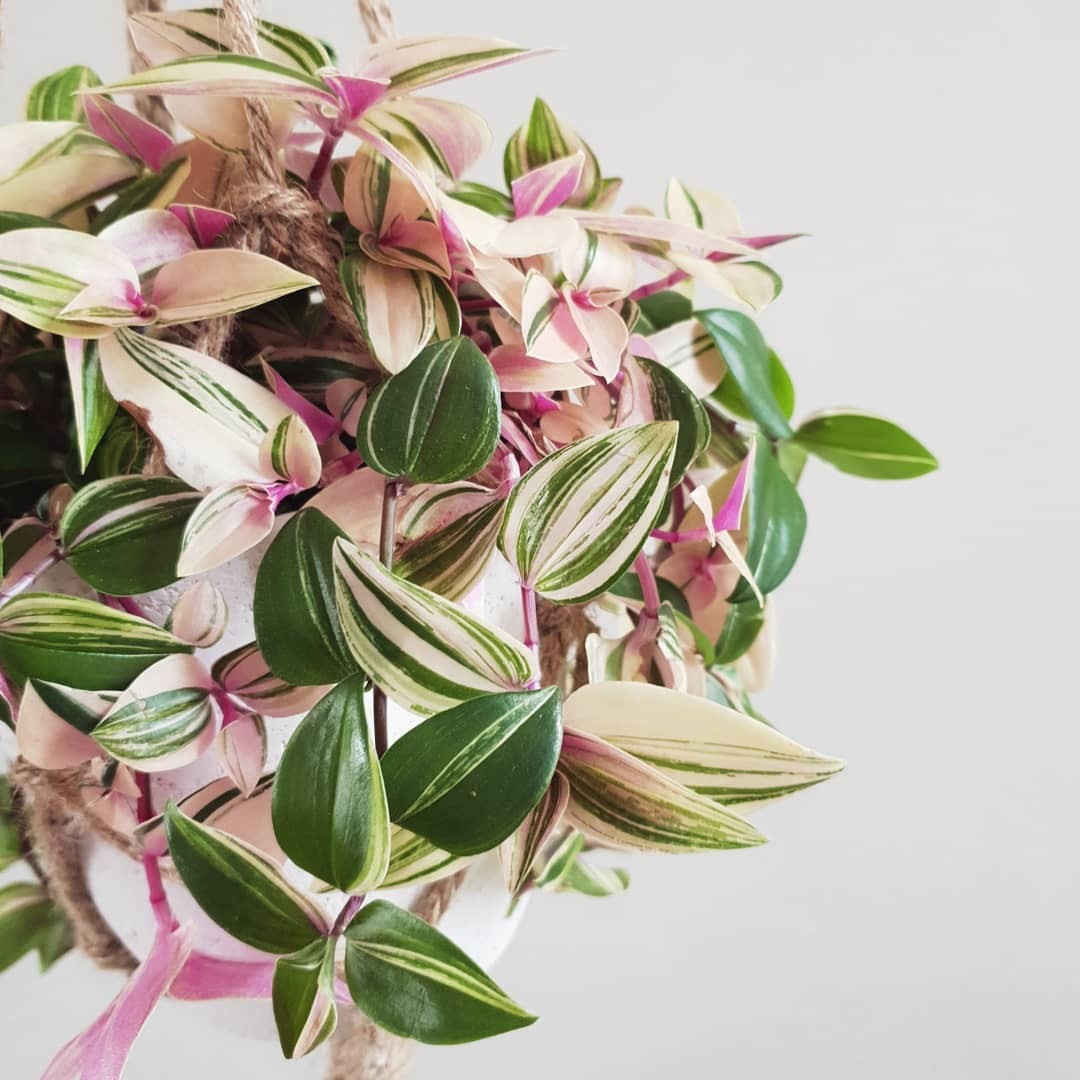
A stalk of a tradescantia in a vessel with water
Some varieties winter well in the ground and are used to decorate the garden, while some are exclusively indoor.
Thick-leaved (thick-leaved)
This succulent has thick, fleshy stems that can retain moisture. The color of the leaves is white-yellow, along with green stripes. The leaves cover the entire length of the stem and are heavily pubescent.
Flowering teaches at the end of winter.
The most famous variety is White Velvet, bred in Brazil. Its distinctive feature is silvery sparkling hairs all over the stem and on the leaves. Vines reach a length of 80 cm. It blooms from early spring to September. The Cotiledon variety is also popular.
White-flowered (Albiflora)
The most popular type found among flower growers.
It was this species that took part in an unusual experiment. Biological scientist David Latimer planted a plant in a vessel 55 years ago and sealed it. Tradescantia is still alive. A special microclimate has formed inside the vessel.
A peculiarity of the species is the presence of stripes along the leaf and white flowers at the end of the stems. Different varieties are distinguished by the color of the stripes:
- White stripe - white;
- Laekenensis - pinkish
- Tricolor (tricolor) - pink and white stripes on a light green background;
- Alba - dark green and white stripes on light green leaves;
- Aurea - yellow leaves with green stripes
Blossfeld (Thai)
Leaves are two-colored - dark green above and lilac below. On the lilac side, the edge, the shape of the leaves is ovoid, with a sharp top.

Tradescantia room
This type of plant does not tolerate direct sun. In the conditions of an apartment, the period of rest is forced - from November to February. It grows quickly, multiplies by shoots and seeds, needs regular anti-aging pruning.
Setcreasia, or purple
Decorative leafy liana. The stems can be up to 1 m in length. The leaves are deep purple, elongated, smooth above and shaggy below.
The plant requires frequent pruning due to its rapid growth (up to 40 cm per year).
If you do not cut it off in time, the stems will break under their own weight.
Tradescantia blooms from March to August with delicate pink flowers. Each bud consists of a corolla around which three petals are gathered. Good lighting and feeding is required during the growing season.
If there is no flowering for several years, then you need to revise the watering regime, temperature and humidity in the room.
Riverside (Fluminensis)
People call this species "woman's gossip" because of the extremely long tangled shoots. At first glance, it is not even clear where their beginning and end are.
The Latin name Fluminensis means "river" and describes the natural habitat of the species.
Another name for the species is myrtle-leaved - shoots with leaves are similar to the branches of a myrtle tree.
River climbing Tradescantia is hygrophilous and requires frequent watering. In nature, shoots grow up to 4 meters in length, in an apartment they rarely reach 1 meter. Can be planted in the garden for the summer, carefully cover before wintering.
The street variety grows well along the banks of artificial reservoirs.
Hybrid varieties are most often grown in apartments:
- Variegata (Variegata);
- Aurea;
- Tricolor Minima;
- Quicksilver.
Quadricolor
Ampelous herbaceous variety with standard smooth leaves. In good light, pink and white stripes are visible on the sheets. The more light, the brighter they are.
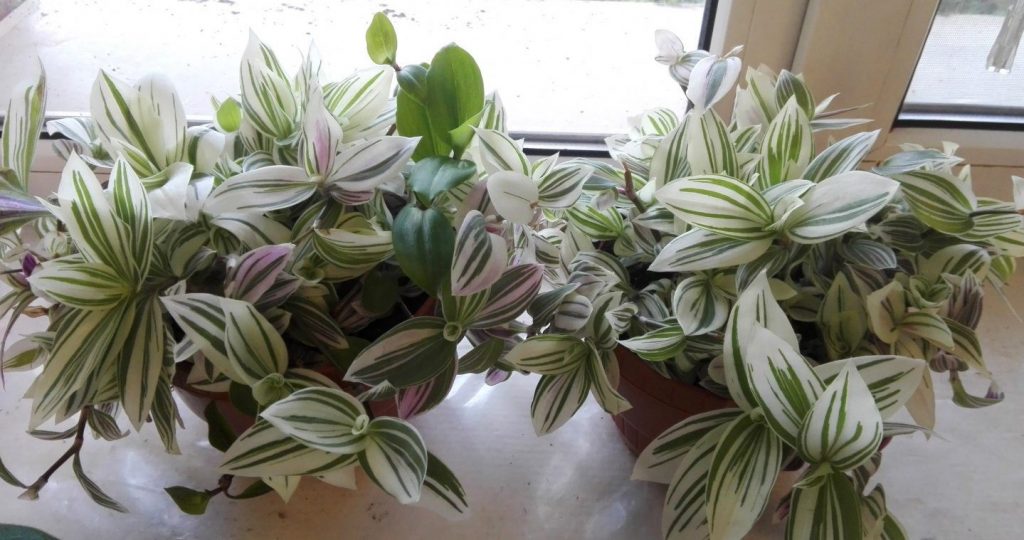
Tradescantia photo room
Shoots are long, twisted up at the tips. This small-leaved variety constantly needs pruning and rejuvenation of the shoots in order to prevent them from breaking off.
Sitara, or Reo
The only decorative Tradescantia on an upright stem. Outwardly, it looks more like a small palm with a dense stele and narrow lilac leaves (they are smooth on top, and velvety below, up to 10 cm long).
It blooms in summer, nondescript whitish inflorescences appear in the leaf axils. After that, small dried crusts with seeds remain. Falling to the ground, they germinate easily without additional conditions.
Rheo comes in several varieties.
- Vittata - characterized by cream stripes along the entire length of the leaf;
- Hawaiian gnome - the leaves are narrow, lilac on top, soft crimson below.
- Sitara gold - yellowish leaves are covered with dark green stripes, and the reverse side is reddish-brown.
Nanouk
Miniature Tradescantia (up to 20 cm) with compact saddles and interestingly colored leaves.
Leaf venation is pronounced, tricolor, with longitudinal green, white and purple stripes.
It is better to plant a plant in small flowerpots, put in a bright light.
Striped (zebrina)
Also called zebra-like.

Tradescantia flower
Feature - the leaves below are dark lilac. The outer side of each leaf is covered with alternating green and white stripes, which gives the plant a decorative and attractive appearance.
The white stripes are silver-cast and look like the glossy surface of reflective flickers.
Violet Hill is gaining popularity around the world.
Yellow hill
This species has a rare color - the leaves are yellow-green with dark stripes. The pattern is unique - stripes of different widths are not symmetrical. Even pure yellow leaves are occasionally found.
The bush is lush, the stems rise by 20-30 cm, then fall off. Because of this, the view of Yellow Hill received such a name - the yellow mountain.
Lodges
Rare view. The leaves are large (up to 20 cm in length) form a basal rosette, the plates are formed in the form of olives.
A wide silvery stripe runs along the green leaf.
Tradescantia blooms with beautiful pink buds (up to 5 cm in diameter).
This species does not form long creeping stems, which makes it similar to rheo. He loves bright lighting, is not intended for landing in open ground - he will die on the street in winter.
Somali (Cyanotis)
A kind of tradescantia, translated means "blue". Stems are long, drooping, leaves are lanceolate, soft and fluffy, collected in separate rosettes.
The foliage above is dark green, below it is blue-violet. Cyanotis blooms extremely rarely. Small red buds are collected in inflorescences, which then dry out and droop, and the seeds spill out downward.
Callisia
People also call it saxifrage or chlorophytum. This variegated form is compact and long flowering.
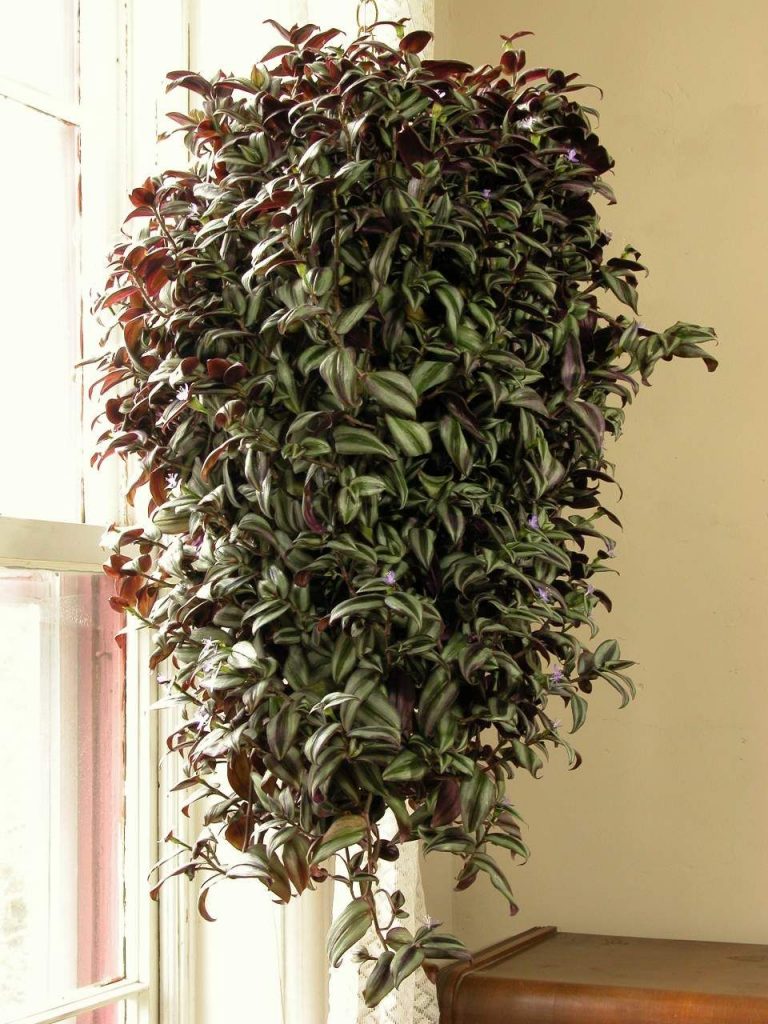
Tradescantia room photo
A miniature hanging plant that does not require complex care: diffused light, temperature + 18-2 ° C, feeding once a month.
The most common variety is the Pink Panther. The Golden Mustache variety is also widely popular. Its medicinal properties have been known for a long time.
Blossfeld
Suitable for open field cultivation, preferably in lowlands, damp places under the shade of trees or taller bushes. Can't stand the direct sun.
In an apartment, it feels better on the western or eastern windows. On the south, shading is required.
The leaves are large, elongated, dark green above, purple below, slightly pubescent. Shoots up to 50 cm long.
In the house, the dormant period lasts from October to February, in the open field it lasts until April.
Wild-growing Tradescantia easily propagates by rooting shoots without separating them from the mother bush. Spreading along the ground, the stems sprout additional roots by themselves.
Sillamontana, or Felt
The most exotic species native to the desert regions of Mexico.
A succulent with a regular symmetrical shape, with unusual leaves completely covered with a white edge. A soft web of silvery hairs covers the entire plant, from roots to apex. Even the buds are all in soft fluff. This gives the plant a special decorative effect.
The flower prefers a dry climate, high temperatures and a minimum of watering. In the shade and with high humidity, it begins to stretch and hurt, it stops blooming.
Conditions: the substrate should be as loose as possible, watering should be rare, and the lighting should be bright. Healthy sillamontana blooms long and profusely with bright scarlet buds.
Spatacea, or multicolor
The plant looks like a rheo. It grows in the form of an erect palm with long, sharp leaves of lilac-green color. Homeland - Central America.

Tradescantia flower
Bloom - from May to October. After the seed pods are formed, self-seeding and germination of new seedlings often occur.
Scaphoid (navicularis)
This species is native to Peru and Mexico. The succulent has bare fleshy stems on which boat leaves are located. Young leaves are almost pressed against the trunk, but as they grow, they stretch out and take the shape of a boat.
In nature, the plant grows, forming dense thickets between cacti. At home, the shoots do not exceed 40 cm in length.
Humidity should be in the range of 50-60%, you should not spray the flower. Needs regular pruning. It propagates well by cuttings at any time of the year.
Pallida (Purple Heart)
An evergreen perennial plant, stems up to 20 cm long, purple in color. The leaves are long, up to 15 cm, purple-green above and dark purple on the back.
Purple Hart is drought tolerant, likes good lighting and moderate humidity levels. The stems are fragile, so they are pruned regularly. A weaving vine breaks easily, you need to tie it up.
Virginia
This species was the first to come to Europe at one time. Shoots are straight, up to 60 cm in height, erect. The leaves are narrow, 15-20 cm long.
The flowers are pale lilac, bloom at sunrise, and by the evening turn into a gel, because of this property, the plant is also called Widow's Tears.
It grows well both at home and in the open field (even in the northern regions), hibernates under the snow without shelter.
The most favorite varieties and hybrids by flower growers:
- Atrorubra (Atrorura) - leaves are pale green, oval, deep red flowers;
- Coerulea (Corulea) - flowers are pale blue;
- Rosea (Rosea) - suitable for growing in the shade, pinkish flowers, collected in small inflorescences;
- Rubra (Rubra) - emerald leaves, emphasize the beauty of ruby-red flowers;
- Rainbow Hill - the stems and the bottom of the leaves are lilac-green, the top is green with wide light stripes. lilac veta. small;
- Fluminensis Albiflora - bluish leaves with green veins. The back side is hairy.
Pink Joy
The leaves are green-pink, small, ovoid, are placed alternately on short petioles. They look very decorative.
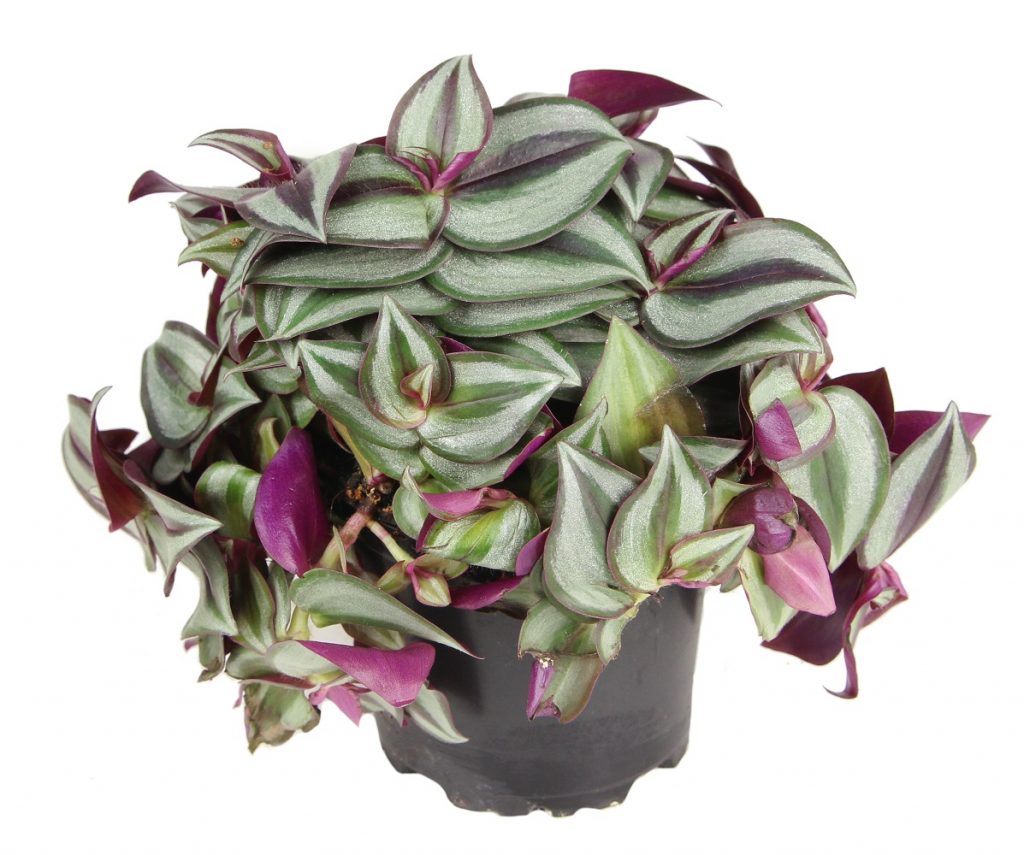
Tradescantia views
Creeping shoots, up to 40 cm in length. Abundant flowering - the entire bush is covered with small white buds.
It requires bright lighting, without which it turns pale, stretches and loses all its attractiveness. Even in winter, the temperature should not drop below + 15 ° С.
This species is thermophilic, easily tolerates short-term drought. Not suitable for planting in open ground.
Garden varieties and hybrids
- White doll and Innocence. White-flowered variety, distinguished by large snow-white buds.
- Angelic Charm. Golden leaves are combined with white flowers. Shoot height - up to 40 cm.
- Blushing bride. Flowers resemble an orchid, delicate pearlescent, do not fall off for a long time.
- Sunshine Charm. Yellow-green leaves and lilac-pink flowers add decorativeness and originality to the variety.
- Max Dubble. Differs in large double buds of dark blue color. The flowering period is from May to August.
- Bilberry Ice. The flowers are white with bright purple accents, the leaves are saber-shaped, often attacked by slugs. It blooms from May to August and is used to decorate ponds.
- Sweet Kate. It has narrow long yellow leaves, which makes it different from other varieties. It blooms with very bright blue buds from June to October. It looks amazing on the flowerbed, it winters well without shelter, even in the most northern regions. Prefers shade and wind protection.
- Anderson's Tradescantia Osprey. It is a perennial grown in gardens - in flower beds, alpine slides and in single compositions. The plant forms a bush up to 80 cm high with branched stems and purple-green leaves. Blooms from early summer to September. The buds are white with blue-lilac veins and a dark fluff in the middle.
- Concord Grape. Height 50 cm, the plant prefers shady areas protected from the wind. The soil loves nutritious, humus, additional feeding is needed during growth and flowering. The species is resistant to diseases, winters well in the ground without shelter.
- Pink Chablis. Bush form. Stem height 50-60 cm, prefers partial shade. Withstands frosts down to -32 ° С. The flowers are pink with a white corrugated border.
- Andersa Little White Doll (Little White Doll). The burgundy and white color of the buds makes the plant unusual. The bush is compact, up to 30 cm in height. Winters well in the ground.
Purchase and adaptation
Tradescantia needs adaptation after purchase. This is especially true for exotic varieties. They are transported in special containers with a peat substrate - the flower will not live in them for a long time.
Be sure to check the soil in which the flower grows. If necessary, immediately transplant it into a more suitable substrate.
The quarantine lasts 2-3 weeks. The plant should be placed separately from other crops already in the house. It may have insect pests or it may be a carrier of infection.
Planting and transplanting
The plant is transplanted for the first time after purchase, preferably not in the fall.

Tradescantia care
At the same time, the pot is not taken high, but wide, so that the flower has the opportunity to grow to the sides. A weak root system does not require a large volume of capacity, but the bush quickly branches and lets out lateral shoots, for which it needs free space.
The soil is chosen nutritious, based on vermicompost. There is an option to buy a universal soil mixture for indoor flowers and supplement it:
- leafy ground;
- sod land;
- humus;
- perlite (coarse sand).
The proportions relative to the purchased land are 3: 2: 2: 2: 1.
Technology:
- Expanded clay, broken clay shards are laid out on the bottom of the container, then a layer of mixed substrate is poured out.
- The plant is planted and sprinkled with earth from all sides - so that a growing point remains on the surface.
- The planted bush is watered with warm water and the flowerpot is placed in partial shade for 1-2 weeks. When it takes root, it is exposed to the sun or some other permanent place in the house.
Tradescantia will quickly adjust to new conditions and grow.
It is better to transplant in the spring, immediately after the flower leaves the dormant period. This is done every 3-4 years. The pot is selected 2-3 cm wider in diameter than the previous one.
Growing conditions at home
Seat selection
Tradescantia feels better on the east and west windows, on the south it requires shading. Young and newly rooted plants can burn delicate leaves.
According to feng shui, tradescantia can be used to decorate walls and shelves by hanging them in special pots. The shoots will braid the wall or hang down freely.
Tradescantia looks good on flower shelves and stands placed in the bedroom, in any corner of the room.
Humidity
Enough 30-40% humidity, it is not necessary to artificially raise it. No pallets with soaked expanded clay and wet rags on the battery - this is superfluous.
Tradescantia easily tolerates the usual apartment microclimate. Only during a prolonged drought, when it is hot in the house, spray the flower with water from a spray bottle.
Temperature
Indoor tradescantia can hibernate without a dormant period. This is convenient, because the heating season in the apartment can be even hot. This unpretentious plant will feel good both at + 20 ° С and +27 ° С.
It can withstand a short-term drop to +12 ° C. This usually happens in the off-season, when it is already cold, but the batteries are not yet heated.
Lighting
Many Tradescantia varieties tolerate direct sun well, but can also grow in partial shade. The plant adapts to different conditions in a short time. If the stems began to stretch too much, it means that the plant does not have enough light. If, on the contrary, they have turned yellow and withered, it is advisable to shade the flower.
Care
Tradescantia, according to most gardeners, is the most unpretentious indoor flower.
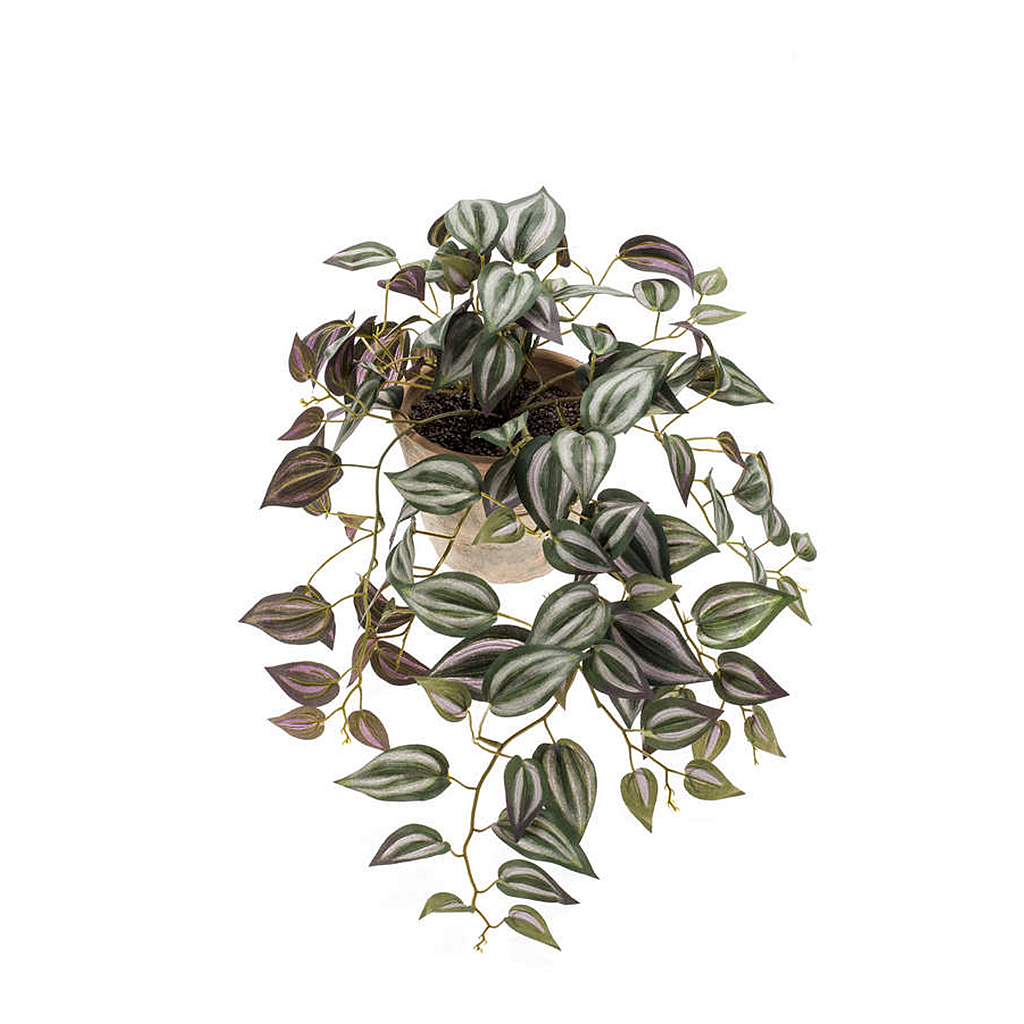
What is thick-leaved tradescantia
However, this does not mean that she does not need to be looked after. The plant will survive even in a harsh stop, but it will be weakened, unattractive, pale, and will stop growing and blooming.
Watering
The water should be settled, soft, at room temperature. It should not stagnate in the pallet, immediately flow out through the drainage holes.
In the spring, watered 2 times a week. In winter, less often, and at low temperatures, watering is minimized so that the roots of the flower do not freeze.
The plant will tolerate a lack of moisture, and an excess can lead to diseases. A humid environment also attracts pests.
Pruning and clothespin
Tradescantia is growing rapidly. Therefore, it needs to be shaped and rejuvenated.If you don't, she gets old and loses her attractiveness.
The stems are elongated, the lower leaves dry and turn yellow. Proper pruning encourages the plant to branch actively, which improves the appearance of the bush.
It is necessary to cut the flower throughout the year, as the shoots grow back. The stem is cut off at a distance of 3-4 cm from the base.
It is not recommended to pinch a flowering plant, but if urgently needed, the oldest shoots are slightly removed.
The inventory must be disinfected before the procedure.
Fertilizers and feeding
From March, they begin to apply liquid top dressing at the root.
Weak roots of Tradescantia are not able to assimilate fertilizers in the form of granules or in any other form. On hot days, spray the flower directly on the leaf.
The main trace element is nitrogen. Phosphorus, potassium and succinic acid are also included in the top dressing, but their concentration is much lower. It is good if substances that provide the shine of the leaves are included.
The best fertilizers:
- Bona Forte for decorative in liquid form. Nitrogen, phosphorus, potassium - 5: 3: 4. Contains magnesium and 7 trace elements. Vitamins C, PP, B1, succinic acid;
- Etisso for decorative foliage. Liquid. Nitrogen. Phosphorus, potassium - 7: 3: 4. Vitamin B1, copper, trace elements;
- Pocon for decorative. Liquid. Nitrogen, phosphorus, potassium - 8: 3: 5. Trace elements, succinic acid;
- Agricola Aqua. Nitrogen, phosphorus, potassium - 5: 3: 4. Trace elements, humate.
Reproduction methods
Tradescantia reproduces easily at any time of the year. Of the simplest ways - cuttings and dividing the bush.

Thick-leaved tradescantia
Seeds
It is better to buy seed material from nurseries or from trusted sellers. Seeds harvested from hybrid varieties may not retain the properties of the parent plant.
Before planting, the seeds need to be prepared: put in a clean cloth and fill with a solution of the drug "Ecosil", "Previkur", "Epin Extra". Keep in liquid for 2-3 hours.
A nutrient substrate is laid out in a container - a mixture of soil for flowers, perlite and vermiculite. Seeds are sown on the surface, without dripping, irrigated with warm water from a spray bottle. The container is covered with foil or thin glass to create a greenhouse effect.
For better germination, the container with seeds is placed under an incandescent lamp so that the temperature on the ground is + 29-30 ° C. Seedlings appear in 10 days. Until this time, the glass or film is not removed. After starting to accustom the sprouts to room temperature, opening the greenhouse for a few minutes.
Important! Do not forget to wipe off condensation in glass or films. If the air humidity is high, mold will appear in the greenhouse and destroy young plants.
The sprouts are planted in separate containers after the appearance of 4-5 full-fledged sheets. This is about 2 months after sowing the seeds. Tradescantia grows very quickly - after 3-4 months the sprouts will turn into an adult flower.
Layers
Vegetative propagation is the most reliable. Another small container with a substrate is placed next to the flowerpot. Then the long stem is bent down and dropped into an additional pot. Water the soil around the liana sprinkled with earth. Within a week, a section of the stem placed in the ground will sprout roots.
You should not immediately separate the seedling from the mother plant. It should harden and begin to grow, releasing the leaves away from the main stem.
After a month, when the root system is fully formed, separate the young plant and put it in its permanent place.
This method of reproduction is especially appropriate with exotic and rare varieties, which are a pity to lose, because it is the most reliable.
Cuttings
Any leafy segment cut from the stem of an adult Tradescantia gives roots. Their size doesn't matter. Cuttings are most often rooted in the substrate, although you can put it in water.
The main thing is that the water only touches the tip of the stem, so that it does not start to rot. It is because of the frequent rotting of cuttings that it is better to plant them immediately in the ground.
Ordinary soil for rooting is poorly suited - it is not light and loose enough. Purchased land has to be supplemented with special small disintegrants: perlite, vermiculite, coarse sand, small foam balls.
Building sand is not prepared for these purposes - it makes the soil heavier and acidic.
The cuttings are first placed in the Kornevin solution for an hour, then they are dropped into the substrate to a depth of 3-4 cm. In warm weather and sufficient lighting, it is not necessary to arrange a greenhouse.
Rooting will take place on the 10-14th day from planting. After 2-3 weeks, the cuttings should be planted in separate flowerpots, and after 2 months they should be looked after as for adult plants.
Dividing an adult plant
The fastest, but also the most risky way. If there is not enough experience, it is better not to take risks, otherwise you can lose both the mother bush and young growth.
The procedure is best done during the transplant. The plant is taken out of the flowerpot completely, gently shaken off the soil and see where to divide the bush. This can be seen right away - an adult bush has several growth points, separate outlets. A similar growth of the bush is known, for example, saintpaulia.
The bush is divided so that each new segment has a growth point. Sometimes they can be separated by hand, sometimes they can be cut with a knife. Pre-disinfect the instrument so as not to introduce infection or fungus into the process. From one adult bush, 3-6 individual plants are obtained.
Only healthy plants are subjected to division. A weakened bush will not be able to give strength to new seedlings. If there are pests, then first cure the flower, and then try to propagate it.
Diseases and pests
| Diseases / pests | Symptoms | Prophylaxis | Treatment |
| Spider mite | Leaves dry out, spots appear. Cobweb between the leaves | Regular inspection, do not overmoisten | Processing "Fitverm", "Aktellikom" |
| Aphid | Insects on young leaves, stem tops | Warm shower once a month. Inspection | Remove insects, treat with a solution of digester soap or "Aktellik" |
| Shield | Brown bumps on the back of the leaves | Regular inspection. Correct watering regime | Remove the insects, spray with Aktellik twice with an interval of 10 days. |
| Slugs (for garden varieties) | Eaten leaves, semicircular gnaws | Regular inspection | Scatter metaldehyde around the bush |
| Root rot | The leaves wither and turn yellow, rot, the stem at the root is soft and lethargic | Do not flood the plant | Urgent transplantation into new soil, after cutting off rotten roots |
Healing properties
Tradescantia has long been referred to as a medicinal plant. By attaching a leaf to the wound, you can quickly stop the blood and speed up healing. The medicated substances contained in the sap of the flower will disinfect the wound and prevent the entry of germs.
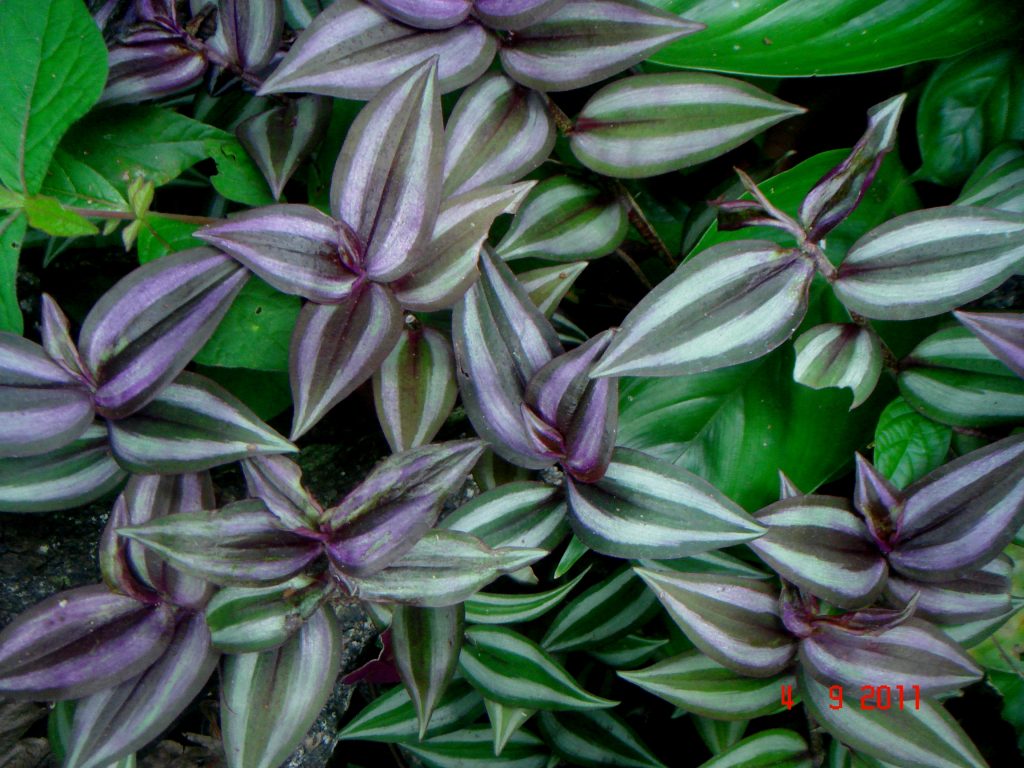
Tradescantia purple
If you rub the juice of diseased gums, you can cure even an advanced form of periodontal disease. On the basis of pomace, drugs are made for colds, stomach diseases and sore throat.
Attention: There are contraindications. Consult a specialist before use.
In the house, the benefits of the plant are obvious - it purifies the air. It has been scientifically proven to capture and neutralize electromagnetic radiation. Therefore, Tradescantia is often kept in office premises, where the body is harmed by working computer equipment.
Important! Tradescantia is poisonous to cats. Make sure that your pet cannot reach the plant.
Useful videos
Tradescantia can become a decoration not only in the interior of the house, but also in the garden. Dozens of species, thousands of varieties - this plant will surprise anyone with a variety of shapes and colors. Beauty, coupled with easy care and beneficial properties, make the color one of the most widespread throughout the world.

